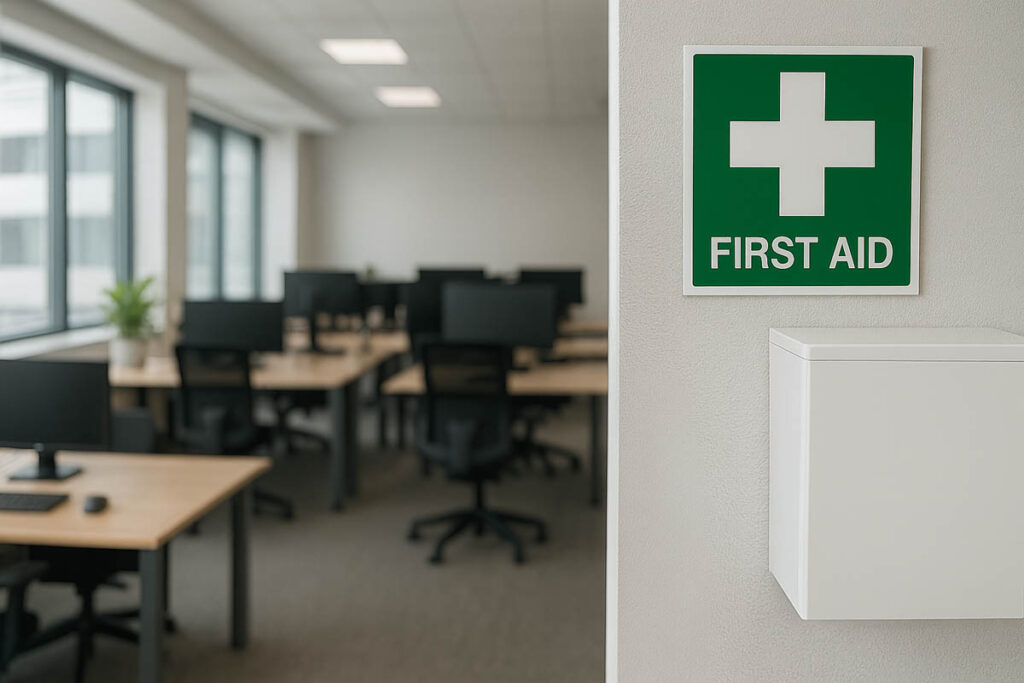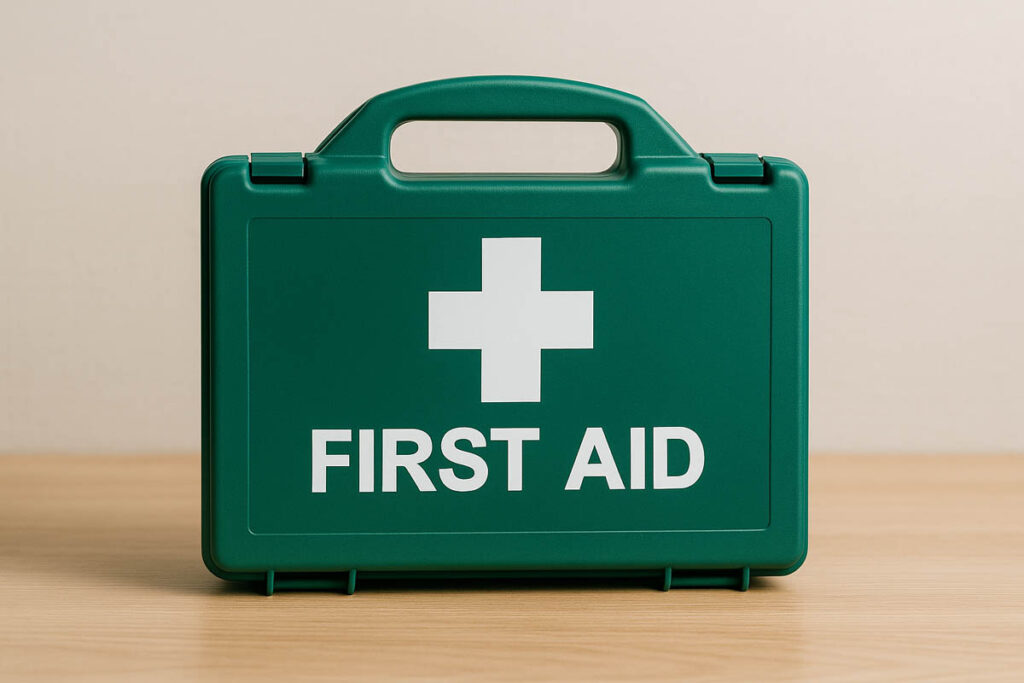
If you are an office manager here in Campbelltown like me, you’ll know that workplace safety can be a minefield of policies and paperwork! To navigate it all successfully, preparation is key. This includes having a proper first aid setup!
I’m writing this post not because I’m a safety expert, but because I’ve been an office manager in Campbelltown for over 10 years now, and I’ve learned a lot about first aid in the workplace that I want to share!
This article breaks down everything I’ve learned:
- What actually belongs in first aid kits for offices?
- How to stay on top of first aid replenishment.
- Whether booking a first aid course in Campbelltown is worth it.
- And how to build a safety culture that doesn’t feel like a chore!
I’m going to focus on first aid kits for offices today, as that’s my area of expertise. However, this advice can benefit any business owner because every workplace needs a first aid kit! Whether you run a busy office, a retail shop, or a small warehouse, first aid readiness can be the difference between a minor incident and a major emergency. So let’s get straight into it so we can all keep our workplaces safe and compliant!
An Office Safety Wake-Up Call
Over the years I’ve spent managing my office, I’ll admit that first aid wasn’t always my top priority. Like many managers, I assumed we were “safe enough.” That changed fast one afternoon when a team member fainted during a heatwave! We had no idea where the first aid kit was, let alone if it had what we needed inside it. Thankfully, the team member was okay, but it was a wake-up call I’ll never forget.
That incident motivated me to research our actual obligations under SafeWork NSW. Legally, every workplace must have accessible, well-stocked first aid kits, trained personnel, and a clear response procedure! It’s not just a box to tick, it’s a duty of care. If someone is seriously injured and you’re unprepared, you’re risking their life, as well as looking at heavy fines, liability claims, and reputational damage that can all follow.
These days, I’ve made first aid a core part of our office safety plan. And the more I talk to other business owners, the more I realise how many of us had to learn the hard way! Hopefully, by sharing this article, I can help someone else get ahead of a crisis before it happens.
What Should Be in First Aid Kits for Offices?

When I first started managing our office, I assumed that our first aid kit had everything we needed… until we actually needed it! Then I realised half the items were expired, others were missing, and it didn’t come close to meeting SafeWork NSW’s recommendations.
A proper office first aid kit needs more than just a few band-aids and antiseptic wipes. At a minimum, your kit should include:
- Adhesive dressings in various sizes
- Sterile gauze swabs and pads
- Antiseptic solution or wipes
- Crepe bandages for sprains or strains
- Disposable gloves (nitrile is best for allergies)
- Scissors and tweezers
- CPR face shield or mask
- Thermal blanket
- Eye wash and saline
- Burn treatment gel or dressings
- Instant cold packs
- Notepad and pen for incident documentation
- First aid guide or instruction booklet
Depending on your workplace environment, you may need additional items, such as EpiPens, asthma relievers, or supplies specific to high-risk situations.
Remember that first aid kits must be easily accessible, clearly labelled, and checked regularly to ensure items haven’t expired or been used without restocking. I recommend assigning this responsibility to a trained first aider or office safety lead!
We now have a system where our kits are checked and replenished quarterly, and it’s made a huge difference. You don’t want to wait for an emergency to find out what’s missing. Investing a little time and effort up front ensures your team is genuinely protected and shows that you take their safety seriously.
Next up, I’ll share the system we use to keep everything up to date!
First Aid Replenishment: The System That Actually Works
Having a first aid kit is one thing, but keeping it fully stocked and compliant is another! In my early days as an office manager in Campbelltown, I assumed once the kit was set up, we were done. But after a minor paper cutter accident and finding we had no antiseptic wipes left, I realised how quickly supplies run out without a system in place.
That’s when I decided to create a system for our replenishment process. First, we created a quarterly reminder to check all first aid kits in the office. One of our trained first aiders is responsible for inspecting the contents, checking expiry dates, and restocking what’s missing. We also keep a simple logbook in each kit, so we can track what’s been used and when!
If you prefer, there is also the option to hire a first aid replenishment service. Several local providers in Campbelltown offer scheduled checks, full restocks, and compliance audits.
But whether you do it yourself or hire a professional service, what matters most is consistency. A first aid kit that looks full but has expired items or missing essentials can be just as risky as having no kit at all!
First Aid Courses in Campbelltown: Are They Worth It?

Many business owners wonder if first aid courses are worth the money. But from experience, I’d say that investing in first aid training for your team is a fantastic decision!
After attending my first HLTAID011 Provide First Aid course, I realised how unprepared I really was. From CPR to managing burns and allergic reactions, the hands-on training gave me the confidence to act quickly and calmly if something ever went wrong.
Under SafeWork NSW guidelines, businesses are required to ensure an adequate number of staff are trained in first aid, based on workplace size, layout, and risk level. In low-risk environments, such as offices, it is generally recommended to have at least one trained first aider for every 25 workers.
Luckily, there are several reputable providers that offer first aid courses in Campbelltown, including nationally accredited courses! Many also offer group sessions on-site, making it easy to train your team without disrupting your business. The courses usually cover:
- Basic life support (CPR)
- Wound care and bandaging
- Managing asthma, anaphylaxis, and choking
- Shock, burns, and head injuries
- Using an AED (defibrillator)
First aid training lasts for three years (CPR refreshed annually), so it’s a long-term investment in your team’s wellbeing. The cost of a course is minimal when you consider what’s at stake: lives, legal risk, and workplace morale. In my experience, trained staff are not only more capable in emergencies, but they’re more confident and engaged overall! So yes, I’d say doing a first aid course in Campbelltown is definitely worth it.
How To Build An Office Safety Culture
Having the right supplies and training is a great start, but building a true office safety culture goes deeper than that. Over the years, I’ve learned that safety only sticks when it becomes part of everyday thinking, not just a one-off meeting. So, how do you create that kind of culture in your workplace? Let me share how I’ve been able to achieve it:
1. Lead by Example
As a manager, your attitude toward safety sets the tone. If you treat first aid and safety protocols as essential, not optional, your team will follow suit!
2. Keep Safety Visible
We’ve put up clear signage for first aid kits, emergency exits, and fire extinguishers. We also run brief refresher sessions during staff meetings and keep emergency contact numbers posted in common areas.
3. Involve Your Team.
Appointing trained first aiders is essential, but it’s also valuable to include staff in regular safety audits and invite feedback about risks they’ve identified. People are more engaged when they feel heard!
4. Make Reporting Easy
We’ve created a simple system for reporting near-misses or hazards without blame. This helps us fix problems early and shows our team that we care more about prevention than punishment.
5. Reward Safe Behaviour
Even a simple thank-you or a shoutout in a team email can reinforce that safety is everyone’s responsibility. When your team feels safe and supported, it reduces risks and boosts morale. Safety becomes something your staff values, not just something they’re told to do.
A strong safety culture isn’t built overnight, but with small, consistent actions, you’ll see changes start to happen!
Check Your First Aid Kits Today!

If there’s one action you take after reading this, let it be this: go check your first aid kit! Is it fully stocked? Are the items up-to-date? Do your staff know where it is and how to use it? Don’t put off workplace safety! As office managers and business owners in Campbelltown, it’s our responsibility to be prepared. I really hope this information will help you create a safer work environment for your team. A few minutes of attention now could prevent serious consequences later!
